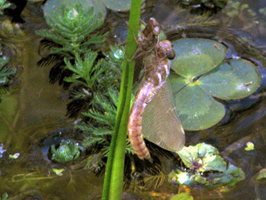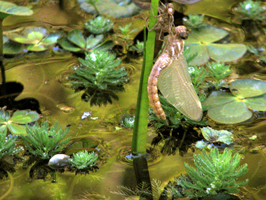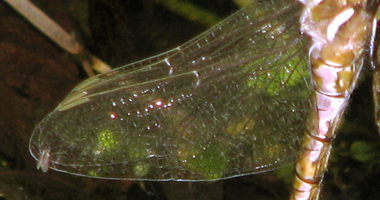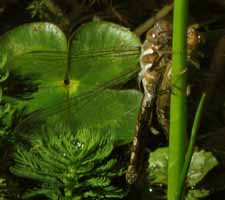A California Darner Emerges, April 2015
Kathy's Bigsnest Pond Blog/Diary
On April 17, we noticed a darner still making it's emergence. Often Darners emerge at nite, to evade predation by birds which
find emerging dragonflies to be tender delicacies.
We spent the next 4 hours recording the event. It was a cool day, which contributed to the long emergence time.
Often Odes can emerge in just an hour or so. (Click any image to see it enlarged)
The first image was taken at 10:46 AM. The nymph had already climbed from under the water where it had been living for the past year,
to a stem of one of our emergent water plants. As is typical for this species, it climbed up to about 3-6" above the waterline.
It's important to provide such plants in a wildlife pond to provide a structure on which the dragonflies can emerge.



If you look closely, you can see that the newly emerged dragonfly is still clinging to the exuvia (shed exoskeleton) that
it had lived in for the last few weeks.
Dragonflies shed their exoskeletons about a dozen times as they grow up - sort of like buying new clothes for a growing child.
Once out of the exoskeleton, the darner puffs itself up with air and fluids, expanding its 'skin' as we would expand our lycra
tights if we ate way too much! :-)
It has already pumped its wings out, and next will await the strength to straighten the body and then to open its wings for the very first time. Prior to this stage,
the wings are in little 'back packs' on the nymph....growing larger and longer with each molt...much as a highschooler's backpack
is heavier than a first graders.
5 mins. later, there isn't too much change, but the side stripes on the thorax, which are unique for each species, already announce to those in the know, that this is
Rhionaeschna californica, known to non-scientists by the English name California Darner. The thin white string-like treads
are actually the tracheal linings of the breathing system the nymph used, no longer needed by the O2 breathing dragonfly.
After another half hour of emergence, the image at the left shows how the dragonfly's body is now hardening up
- what was pale and soft, is now stronger.



A close examination of the wing of the emerging darner shows that it is already being parasitized by a small 'blood' sucking fly!
Finally, at 2:53, the emerging darner spreads its wings for the very first time. For the rest of its life, it will never again close them.
Only Damselflies close their wings as adults. BTW: this is a female darner, determined by 2, not 3, terminal appendages and by
her ovipositor and lack of a bump under s2. By 2:57 she was shivering her wings, to warm up her flight muscles, and then off she went.
The parasitic fly no longer seemed to be with her.


